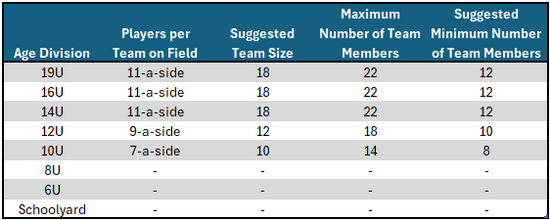Roster Size
As of August 1, 2025, roster sizes were increased to allow more players per team and still provide at least 50% playing time for players.
For players ages 7 and younger, roster limits are no longer set, allowing Regions to utilize alternative formats for the maximum number of kids on the field.
This new framework presents the opportunity to be more creative and flexible with your game models and ultimately can help alleviate today’s top 3 challenges to running a Region:
- Lack of volunteers (and the need for easier entry)
- Field space limitations (access, space and availability)
- Engagement issues (we get players earlier, but they are leaving earlier)
With the new roster adjustments, you have freedom to create more organic and perhaps less structured programs. Hugely successful during our pandemic challenges, what were once band aids now become potential solutions.
Benefits of Less Structured Model
| Aspect | Less Structured Play | Structured Play |
| Control | Child-led | Adult-led |
| Creativity | High (open-ended) | Moderate (goal-oriented) |
| Social Interaction | Peer-driven, spontaneous | Often guided or supervised |
| Learning Style | Exploratory, experiential | Instructional, skill-based |
| Emotional Impact | Relaxing, empowering | Can be rewarding but sometimes stressful |
Accessible and Inclusive
All you need is a ball and a bit of space. AYSO welcomes everyone—regardless of skill level, background, or resources. And a more organic play environment is the most democratic form of the game, and often the most beautiful.
To summarize and address our own challenges (and beyond), a less-structured model:
· Requires fewer volunteers
· Requires less coach-specific training easing entry (coach vs. activity captain)
· Requires less space due to smaller sided games
· Requires less equipment, helping lower cost (pinnies, vs. uniforms, designated teams vs. jamboree?)
· Will retain players! When kids are free to explore and have ownership they stay engaged longer. They play because they want to, not because they have to. And that intrinsic motivation is the foundation of lifelong passion and performance.
So, feel free to rethink the way we develop young players. Let’s create more spaces where the game belongs to the kids. Where the ball is the teacher, and the field is a canvas for imagination.
Need assistance implementing alternative formats? Email: programs@ayso.org.


